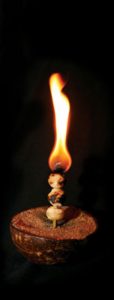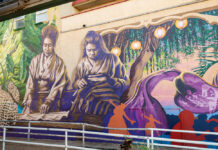 But of all the uses of the kukui, none is more famous or beloved than the property that gives it its name, for “kukui” means “light” or “torch,” and its English name is “the candlenut tree.” When the shelled nuts were skewered on a coconut frond mid-rib and lit from the top to bottom, the oil in the kernels caused them to burn for several minutes. The nuts could be adapted to lama (ti-leaf sheath torches) and kalïkukui (candles), pohokukui (stone lamps), and even stuffed in bamboo shafts for torch fishing at night.
But of all the uses of the kukui, none is more famous or beloved than the property that gives it its name, for “kukui” means “light” or “torch,” and its English name is “the candlenut tree.” When the shelled nuts were skewered on a coconut frond mid-rib and lit from the top to bottom, the oil in the kernels caused them to burn for several minutes. The nuts could be adapted to lama (ti-leaf sheath torches) and kalïkukui (candles), pohokukui (stone lamps), and even stuffed in bamboo shafts for torch fishing at night.
From this amazing property of the kukui comes its kaona, its spiritual import. The tree of light has become a symbol of enlightenment, protection, guidance, and peace, and as such its mana (spiritual power) flows through Hawaiian culture and its ceremonies. The tree is considered to be the kinolau, or vegetable form, of Kamapua‘a, the pig god, the lover of fire goddess Pele (perhaps due to light’s affinity with fire) and so a pig’s head carved from kukui wood is placed on the altar to Lono at the annual Makahiki festival. The moku ka piko ceremony, the cutting of the umbilical cord, also symbolically extends to the consecration of a house. In ancient times kukui was woven into the thatched house to confer its blessings, and for modern houses a bundle of thatch mixed with kukui is used in the ceremony.
Dr. Winter told me he wears a kukui leaf or kukui nut lei “when giving a presentation where I need to speak from wisdom.” Kukui leis, made by braiding leaf stems together and inserting the kukui’s small white flowers between them, have not only a spiritual but a political meaning. The kukui bloom is Moloka‘i’s island flower, and the island’s symbolic color is the leaf’s silver-green. And in 1959, the kukui itself was made the official tree emblem for the state of Hawai‘i.
The kukui tree maintains its practical usefulness, planted as a shade tree or for soil stabilization, its nut oil touted as relief for sunburn and eczema, its hard black nuts used in leis. But sustaining the tradition of reverence and love for the kukui is closest to the hearts of many of the people I spoke with. Dr. Paul Higashino, restoration manager of Kaho‘olawe, told me that kukui will one day be planted in the valleys there with seeds collected from Maui and be present on Maui Nui’s reclaimed spiritual island. Elsewhere in Maui Nui, at Pu‘u Huku near Keopuka Loa Valley in Moloka‘i, is a sacred grove of kukui trees believed to be planted by the gods and revered for its mana. That grove is now protected under the state’s Exceptional Tree Ordinance.
The desire to sustain the kukui’s role as a spiritual vessel of enlightenment comes through in an ancient Polynesian custom that, as Dr. Abbott says, teaches children about the lights. They were often given the responsibility of keeping the kukui “candles” lit. From that tradition comes one of the most beautiful ‘olelo no‘eau concerning kukui, said to have been originally recited by a Tahitian mother to her son, which poetically links the continuation of the ‘ohana (family) and their enlightenment with the illumination shed by a chain of kukui seeds. “The seed was sown. It budded, it blossomed. It spread out and budded again and joined line on line, like the candlenut strung on one stem. ‘Tis lighted. It burns aglow and sheds its light o’er the land.”





